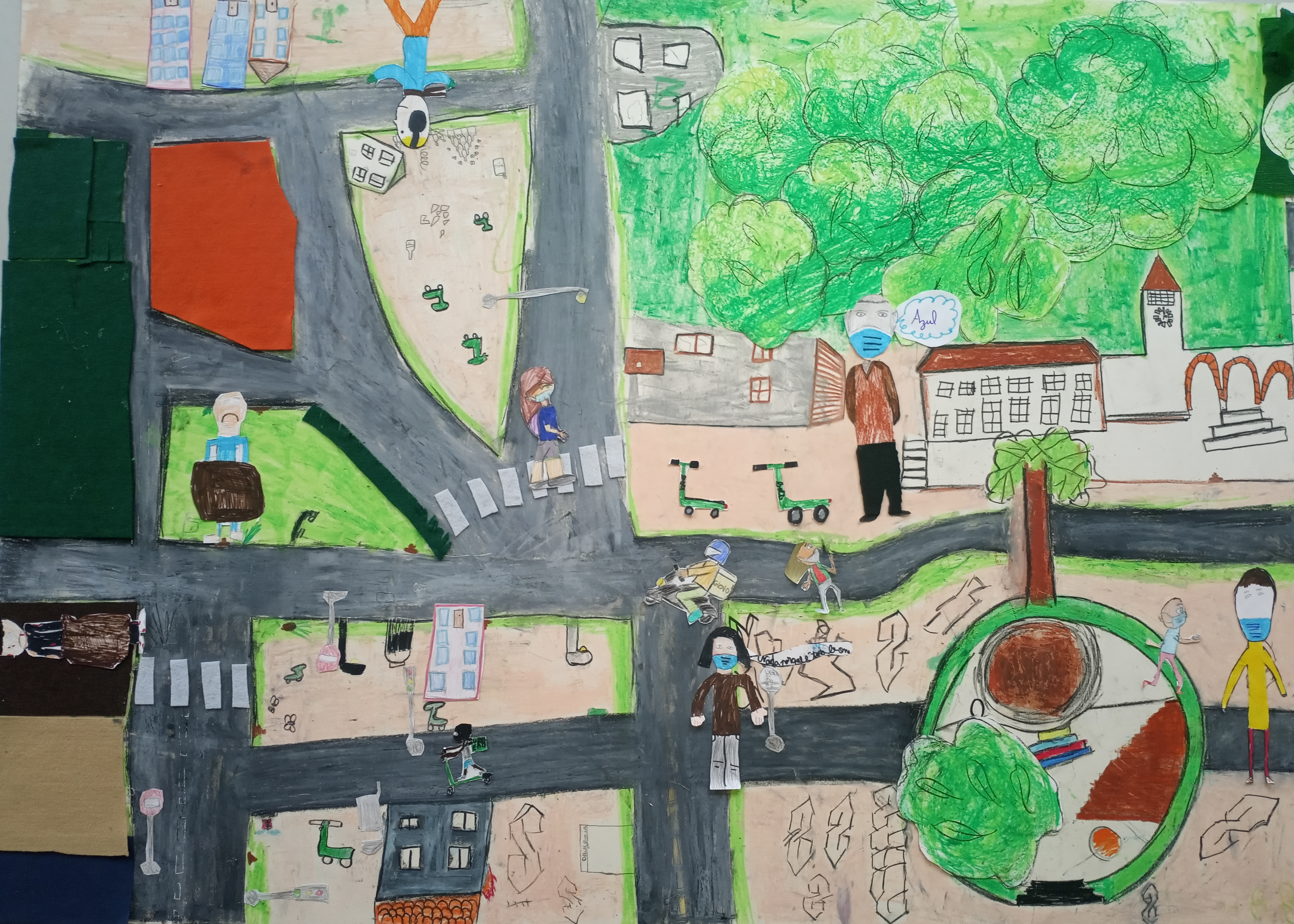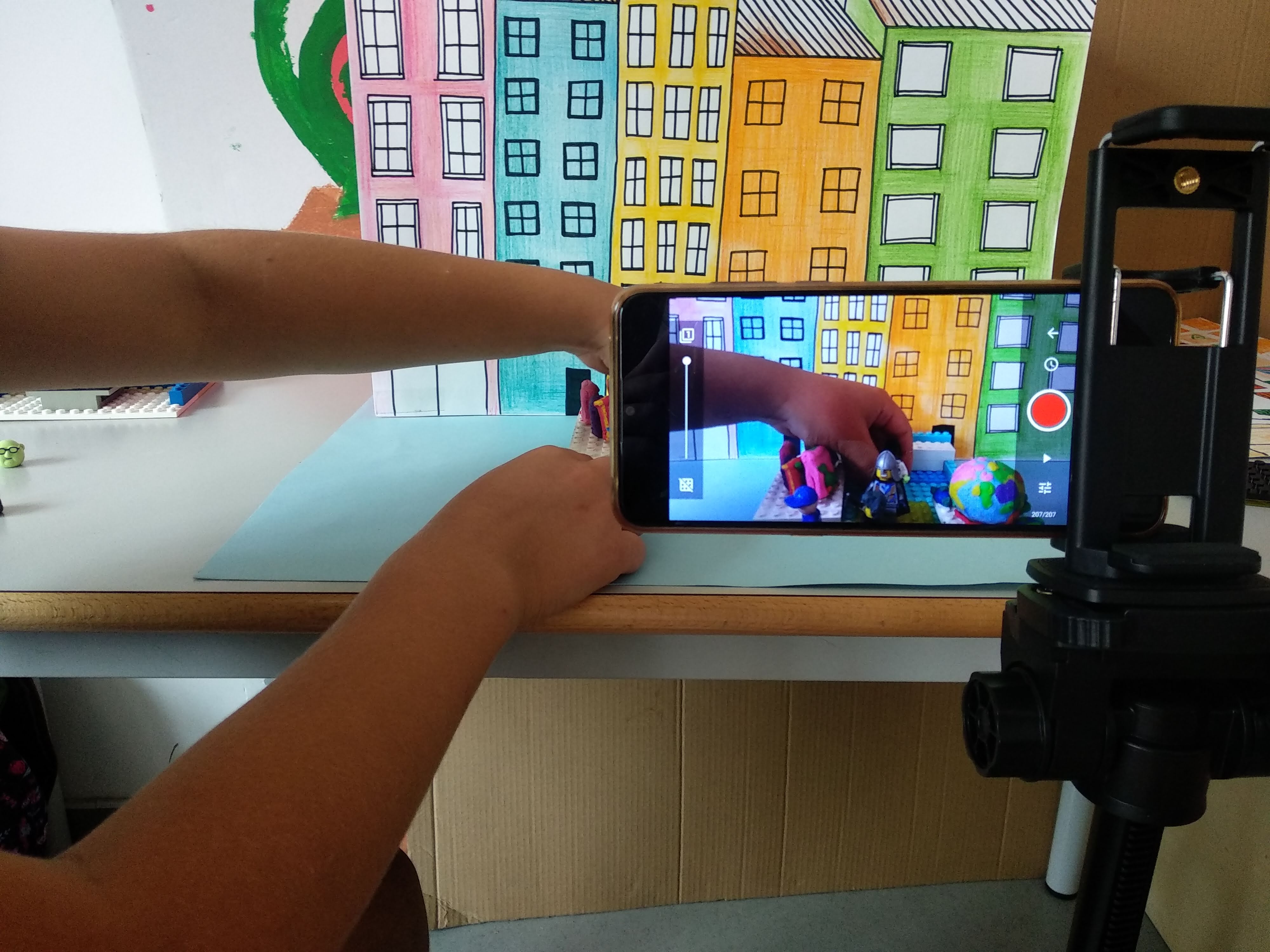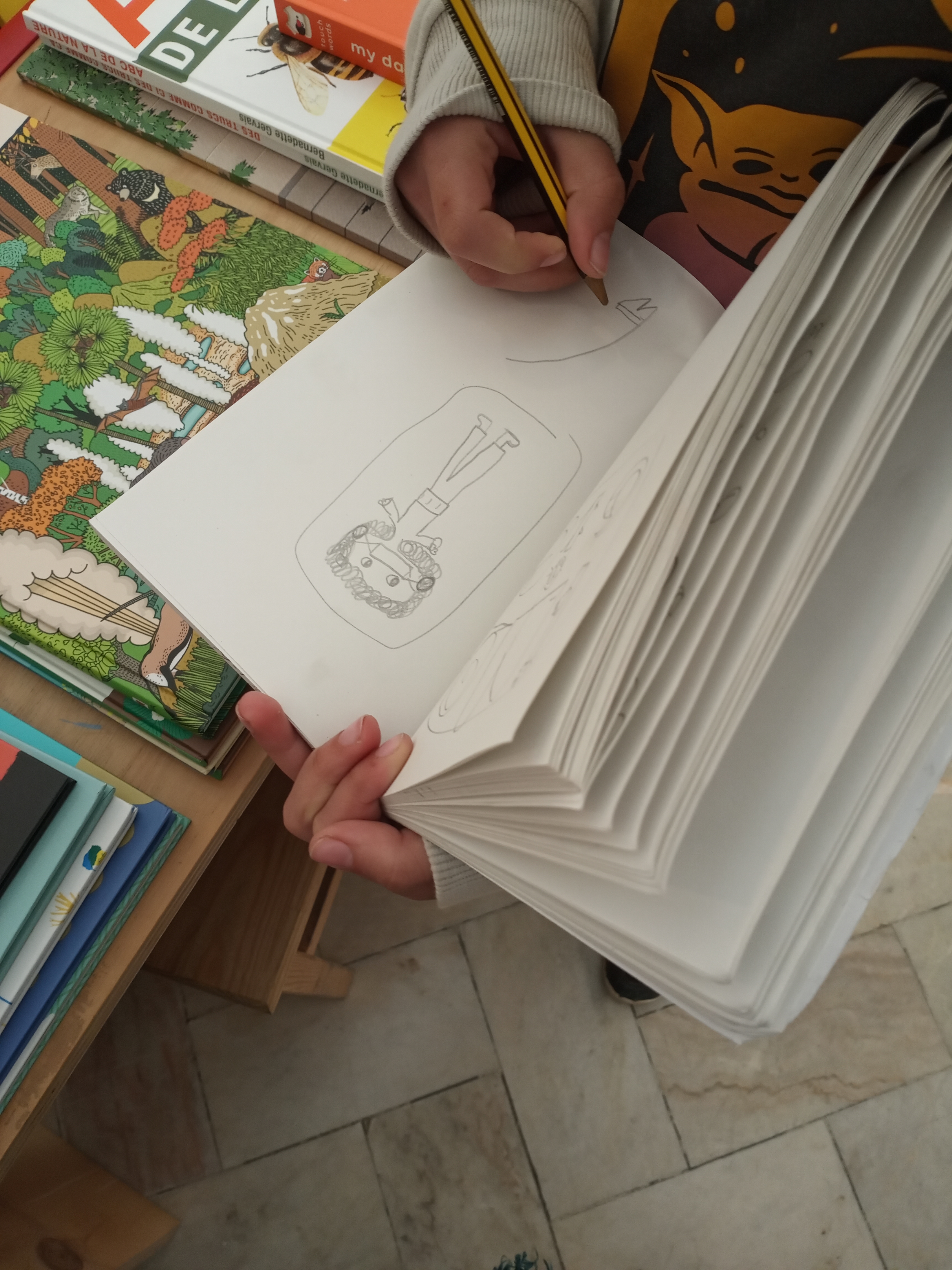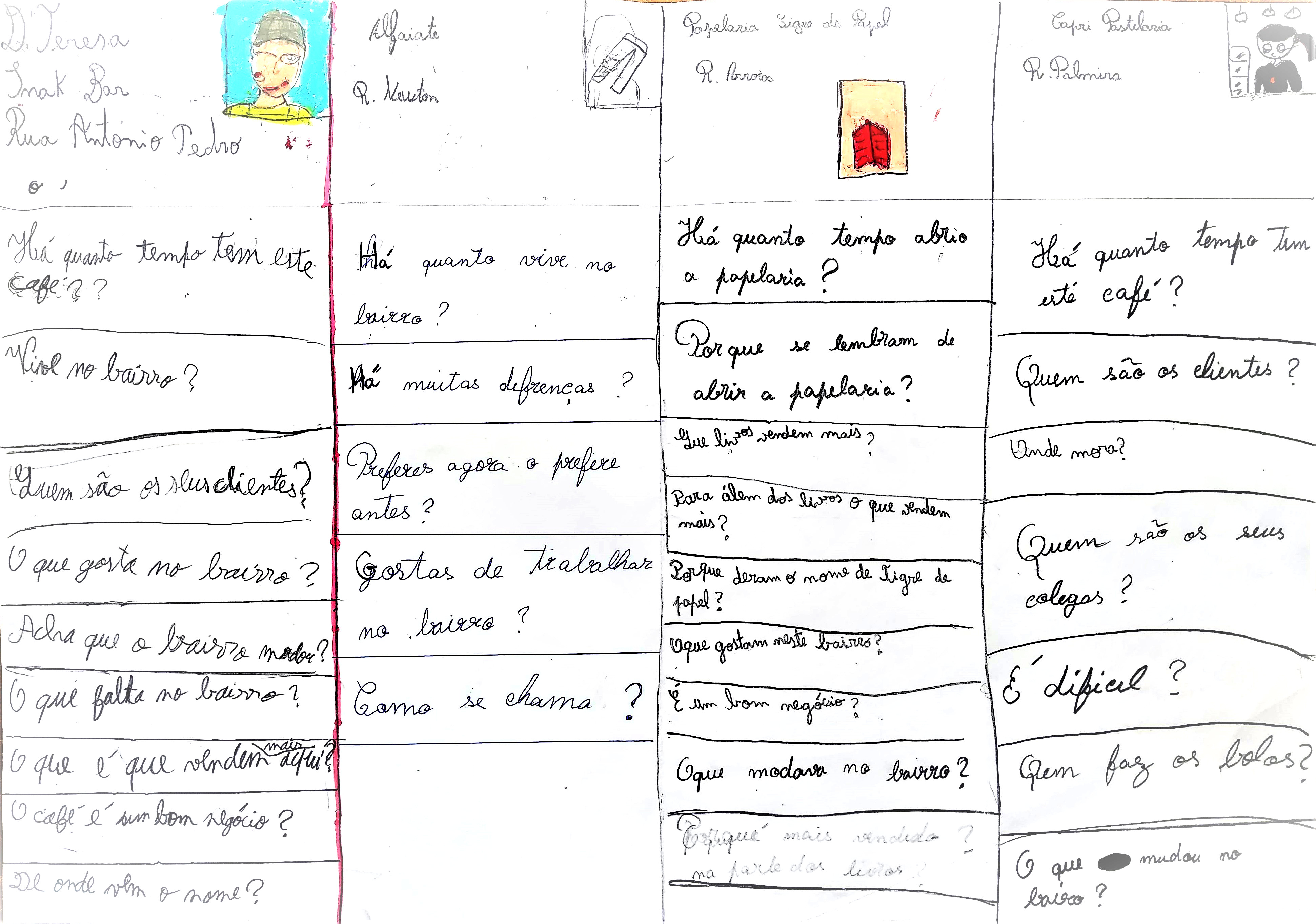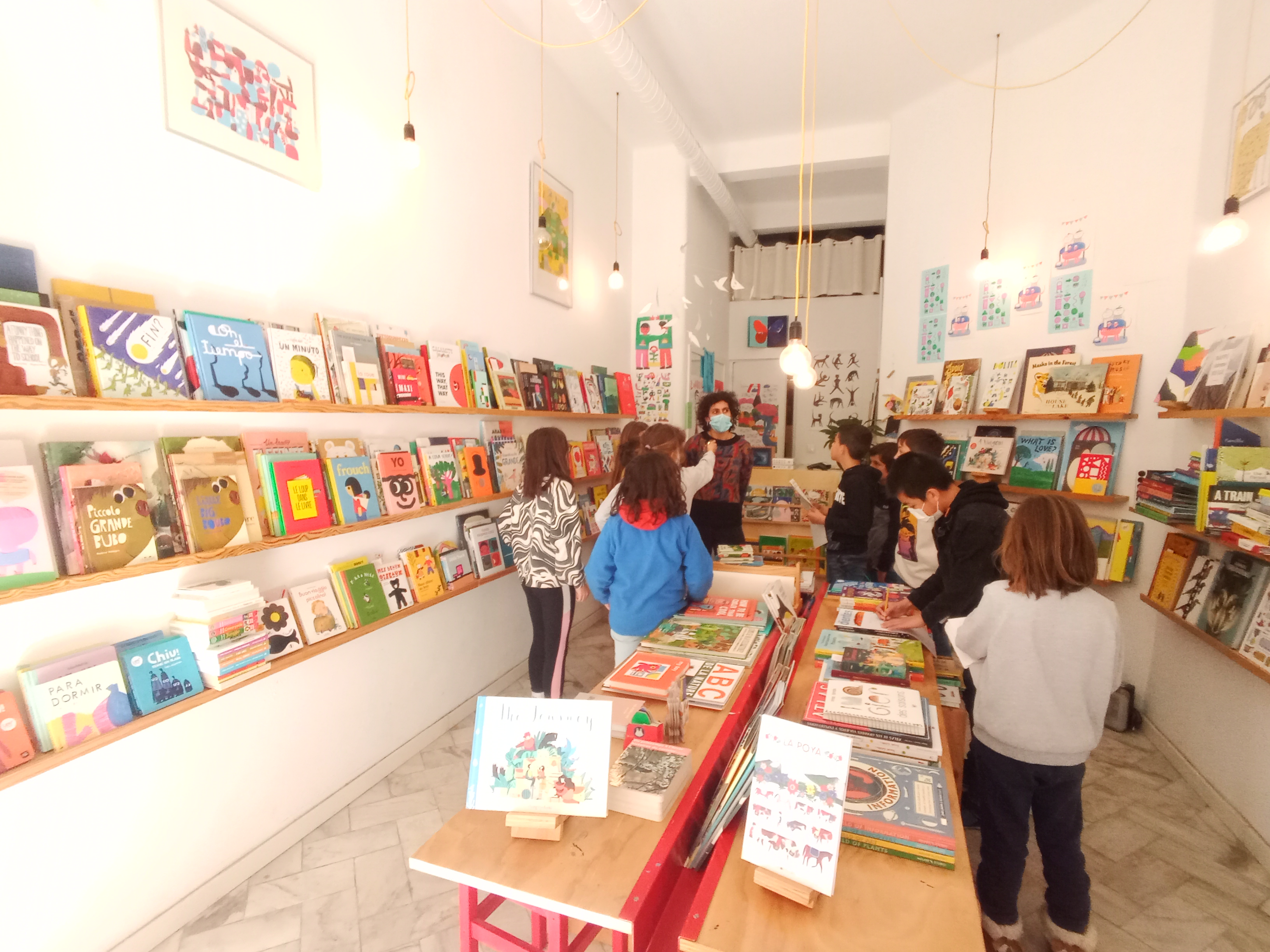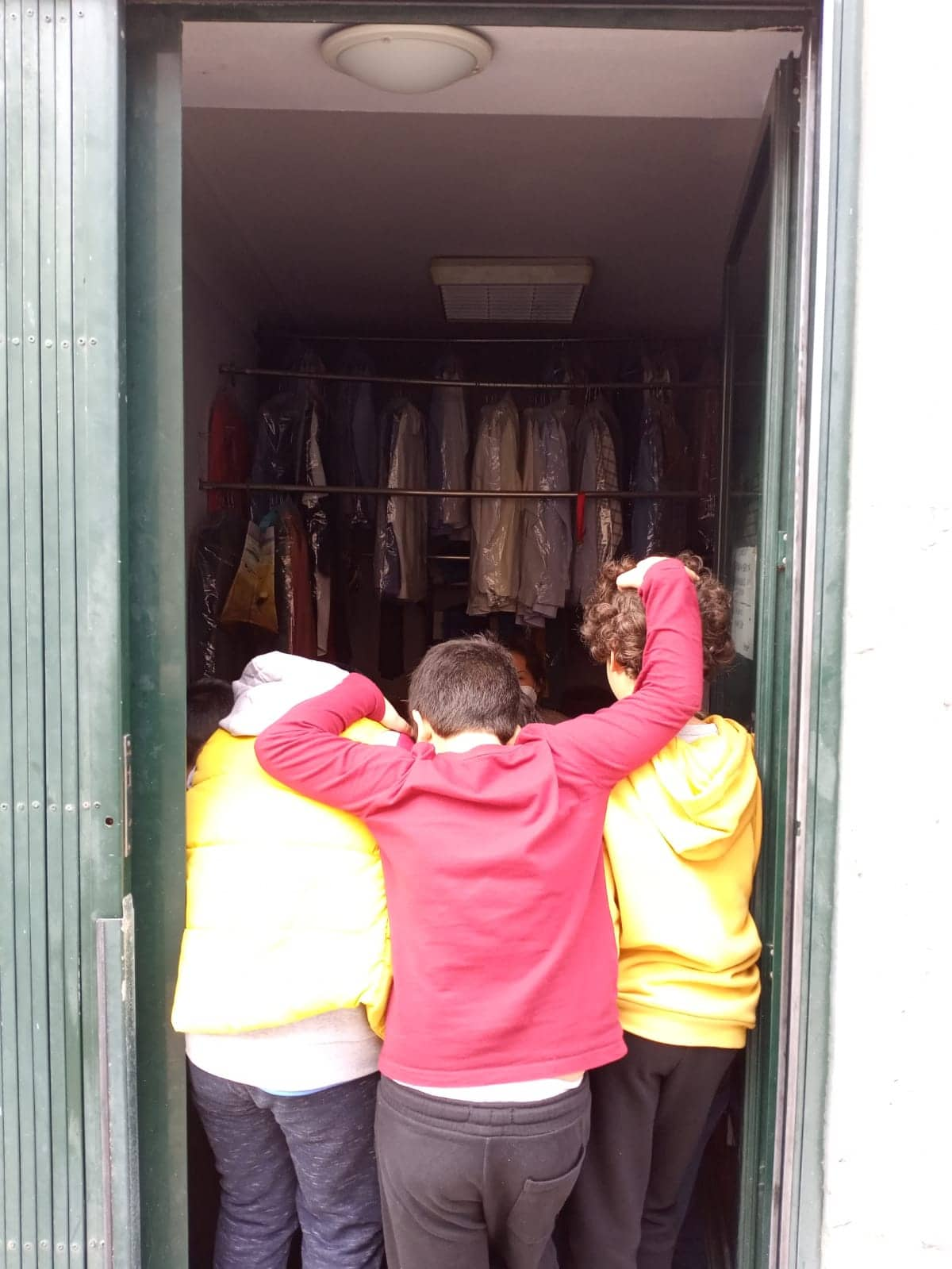Regaining a sense of belonging
Diving in the neighbourhood
Diving in the neighbourhood - with the children
How can we create a sense of belonging in changing urban contexts? How can we learn across differences and changes? Diving in the neighbourhood with the children is an invite to explore these questions through transforming our local context into spaces of collective learning.
Portugal
Local
Lisbon
Anjos neighbourhood
Anjos neighbourhood
Mainly urban
It refers to other types of transformations (soft investment)
Yes
2024-04-11
No
No
No
As an individual partnership with other persons/organisation(s)
How can we create a sense of belonging in changing urban contexts? How can we learn across differences and changes? Diving in the neighbourhood with the children is an invite to explore these questions through transforming our local context into spaces of collective learning.
This project in its first phase - a multimodal, collaborative, ethnographic learning adventure - centered the children's curiousities and voices to learn about their neighbourhood and its community life in Lisbon (Anjos neighbourhood), to create multiple layers of belonging through collecting stories and experiences.
In its second phase it experimented with a series of collaborative cultural productions to make sense, share and further create based on the collected materials.
The project transforms the neighbourhood into a space of learning across cultures, generations and times. It builds capacities to be together, learn together in a way that appreciates the knowledge and experiences of all who make our neighbourhoods. It does so, in an urban context under radical transformations, where multiple conflicts shape the everyday life.
Centering children and their ability to create knowledge on their neighbourhood, it proposes a radically different idea of epistemic justice when it comes to how we think about our cities.
This project in its first phase - a multimodal, collaborative, ethnographic learning adventure - centered the children's curiousities and voices to learn about their neighbourhood and its community life in Lisbon (Anjos neighbourhood), to create multiple layers of belonging through collecting stories and experiences.
In its second phase it experimented with a series of collaborative cultural productions to make sense, share and further create based on the collected materials.
The project transforms the neighbourhood into a space of learning across cultures, generations and times. It builds capacities to be together, learn together in a way that appreciates the knowledge and experiences of all who make our neighbourhoods. It does so, in an urban context under radical transformations, where multiple conflicts shape the everyday life.
Centering children and their ability to create knowledge on their neighbourhood, it proposes a radically different idea of epistemic justice when it comes to how we think about our cities.
learning
neighbourhood
transformation
belonging
children
The project’s main objective was to position the neighbourhood and its community life as context of learning to regain a sense of belonging and ownership of the urban space and act upon them. This focus implies building the ground for individual and collective actions towards sustainability through the lens of the immediate context. As it is highlighted also in the Sustainable and Just Cities initiative’s work, individual and grassroots community knowledge and action are key to demand more just and sustainable cities.
The focus on the neighbourhood and the collaboration with local schools, cultural spaces and commerce strongly resonates with the 15 minutes city concept, raising awareness on both the importance of community life and decentralised urban services, leading for instance to more local consumption and less commute. In this sense, learning to value the immediate urban context is a basis for creating cities that are at the service of people and at the same time are respectful towards the environment.
Reconnecting and dynamising the local context go hand in hand with a critical view on cities’ environmental impact. The growth and rapid transformation of cities, which is the case of Lisbon, put at risk the existence of vibrant communities which are at the core of collective actions towards sustainability. It is urgent to advocate for a different city model.
Beyond this, to walk the talk, the project instead of building new infrastructure, advocates for using, rethinking and resignifying local spaces, as well as prioritising the reuse of equipment and materials already available in the community.
The focus on the neighbourhood and the collaboration with local schools, cultural spaces and commerce strongly resonates with the 15 minutes city concept, raising awareness on both the importance of community life and decentralised urban services, leading for instance to more local consumption and less commute. In this sense, learning to value the immediate urban context is a basis for creating cities that are at the service of people and at the same time are respectful towards the environment.
Reconnecting and dynamising the local context go hand in hand with a critical view on cities’ environmental impact. The growth and rapid transformation of cities, which is the case of Lisbon, put at risk the existence of vibrant communities which are at the core of collective actions towards sustainability. It is urgent to advocate for a different city model.
Beyond this, to walk the talk, the project instead of building new infrastructure, advocates for using, rethinking and resignifying local spaces, as well as prioritising the reuse of equipment and materials already available in the community.
Aesthetics and sustainability go hand in hand in this project. Working in spaces and places and with equipment that already exist in the neighbourhood, means a commitment to the principles of degrowth and good life.
The neighbourhood where the project took place is a crowded urban space from an architectural, traffic and human point of view. In order to resignify their sense of belonging towards the neighbourhood where they live in, the children walked through it, participating in listening exercises with their eyes closed and silent observation, stopping and sitting in public spaces. They entered the local shops and cultural spaces, to understand questions of permanence and impermanence in a neighbourhood community in the middle of a capital city. Thus, instead of building new infrastructure, they created networks of meanings and possible projections onto what in the neighbourhood already exists.
This project centers children's voices in the production of knowledge and culture connected to the neighbourhood.
The culture produced by children in this project creates a particular aesthetic experience in the sense that it captures the process of construction of multiple relationships and meanings (intercultural, intergenerational, local and global) projected onto place in continuous transformation, a truly urban experience.
The neighbourhood where the project took place is a crowded urban space from an architectural, traffic and human point of view. In order to resignify their sense of belonging towards the neighbourhood where they live in, the children walked through it, participating in listening exercises with their eyes closed and silent observation, stopping and sitting in public spaces. They entered the local shops and cultural spaces, to understand questions of permanence and impermanence in a neighbourhood community in the middle of a capital city. Thus, instead of building new infrastructure, they created networks of meanings and possible projections onto what in the neighbourhood already exists.
This project centers children's voices in the production of knowledge and culture connected to the neighbourhood.
The culture produced by children in this project creates a particular aesthetic experience in the sense that it captures the process of construction of multiple relationships and meanings (intercultural, intergenerational, local and global) projected onto place in continuous transformation, a truly urban experience.
The lens of ‘neighbourhood life’ offers a good entry point into examining and documenting the cultural diversity of the context, without focusing on one or other group and allows for the emergence of transversal topics. In this specific case, not only the children and their families show a huge cultural diversity, from all parts of the world, but also, the project's focus was a neighbourhood in the centre of Lisbon that is in continuous transformation.
In this project, the children of two primary school classes carried out an urban ethnographic work in their neighbourhood: they were the protagonists as residents of the neighbourhood and as active subjects in all the dimensions of the project: discussion and production of knowledge about the neighbourhood, where they lived and where the project took place.
With this exemplary approach of horizontal design, centering children's voices and decisions throughout the process, we are suggesting reading inclusion as a process created by children, taking charge of relationships in the neighbourhood.
In fact, the diversity of experiences was the result of the possibility for children to circulate in the neighbourhood and to create, together with local shop owners and cultural actors, a complex network of knowledge and perspectives about the local community: what kind of services, public transport, spaces for fun, shops, food, culture are desidered or, in same cases, are missing. Working on such a neighbourhood organically leads to documenting and preserving the diversity of cultural practices through the stories of the interviewed shop owners and residents. Moreover, the relationships established and the narratives collected allowed intergenerational connections throughout the process.
These living archives are containers of future transgenerational knowledge, thus can potentially improve people’s and communities’ inclusion on the long term, sharing collective narratives and practices.
In this project, the children of two primary school classes carried out an urban ethnographic work in their neighbourhood: they were the protagonists as residents of the neighbourhood and as active subjects in all the dimensions of the project: discussion and production of knowledge about the neighbourhood, where they lived and where the project took place.
With this exemplary approach of horizontal design, centering children's voices and decisions throughout the process, we are suggesting reading inclusion as a process created by children, taking charge of relationships in the neighbourhood.
In fact, the diversity of experiences was the result of the possibility for children to circulate in the neighbourhood and to create, together with local shop owners and cultural actors, a complex network of knowledge and perspectives about the local community: what kind of services, public transport, spaces for fun, shops, food, culture are desidered or, in same cases, are missing. Working on such a neighbourhood organically leads to documenting and preserving the diversity of cultural practices through the stories of the interviewed shop owners and residents. Moreover, the relationships established and the narratives collected allowed intergenerational connections throughout the process.
These living archives are containers of future transgenerational knowledge, thus can potentially improve people’s and communities’ inclusion on the long term, sharing collective narratives and practices.
The first phase of the project was also a demand for space by the children who are citizens of the neighbourhood. Colourful QR Codes with information about the project and its creations were put on shop doors so that the public could access this material and learn more about local businesses, their owners or workers and their role in the social network of the neighbourhood where they live. At the end of the school year, the presentation of the children's work and their creations was held in a public square in front of the school, where residents, passers-by, students and their families, teachers and shopkeepers could participate, enjoy and learn about the whole process, as well about the neighbourhood, through the children's voices. The children offered also a guided tour through the neighbourhood for adults. The created materials are also a collective archive of all persons involved.
These activities were planned in a way to involve the local community in an informal, funny and fluid way. The impact of this engagement has resulted in a multiplication of perspectives about the neighbourhood, not only as a space of live and work, but also as a place for relationships, affects, multiple and different belongings. In the second phase of the project, we created other artistic interventions, unfolding the collected material, bringing them to different cultural spaces of the neighbourhood and to some other around the city. The aim was to captivate the curiosity of other residents and citizens who would not expect, for example, to find children organising an event in those places, dedicated to a generally adult audience and would not expect to have the opportunity to dance, chat and eat popcorn with children as protagonists of a creative process, as well of the space. In other cases, when the children weren't present, participants were invited to adopt the children's perspective about the urban space and learn about the neighbourhood through their creations.
These activities were planned in a way to involve the local community in an informal, funny and fluid way. The impact of this engagement has resulted in a multiplication of perspectives about the neighbourhood, not only as a space of live and work, but also as a place for relationships, affects, multiple and different belongings. In the second phase of the project, we created other artistic interventions, unfolding the collected material, bringing them to different cultural spaces of the neighbourhood and to some other around the city. The aim was to captivate the curiosity of other residents and citizens who would not expect, for example, to find children organising an event in those places, dedicated to a generally adult audience and would not expect to have the opportunity to dance, chat and eat popcorn with children as protagonists of a creative process, as well of the space. In other cases, when the children weren't present, participants were invited to adopt the children's perspective about the urban space and learn about the neighbourhood through their creations.
The project since its beginning was designed in a way to involve a variety of stakeholders, in the design but also in the dissemination of the project results. The children, the teachers, the local community members, the school group, the city council, the cultural spaces, community centres, the university were all involved, however through different mechanisms and to different extent.
The first phase of the project involved a structured collaboration with a local school. The final design of the project was defined in collaboration of the facilitators/researchers and the teachers. The design of the final exhibition at the end of the first phase was carried out in partnership with a local cultural festival to ensure the results of the project feed back to the local community and its cultural scene.
In the second phase of the project we collaborated with a series of community and cultural spaces, and together with children who participated in the first phase, co-designed the interventions adapted to each place and their audience.
The first phase of the project counted with the financial support of the city council, whose representative followed the project development and participated in the final event. The Center for Research in Anthropology was a partner in the first phase of the project, creating an immediate bridge with the university.
These bridges are fundamental to contextualise such a project and its potential.
The first phase of the project involved a structured collaboration with a local school. The final design of the project was defined in collaboration of the facilitators/researchers and the teachers. The design of the final exhibition at the end of the first phase was carried out in partnership with a local cultural festival to ensure the results of the project feed back to the local community and its cultural scene.
In the second phase of the project we collaborated with a series of community and cultural spaces, and together with children who participated in the first phase, co-designed the interventions adapted to each place and their audience.
The first phase of the project counted with the financial support of the city council, whose representative followed the project development and participated in the final event. The Center for Research in Anthropology was a partner in the first phase of the project, creating an immediate bridge with the university.
These bridges are fundamental to contextualise such a project and its potential.
The project applied a two level transdisciplinary approach: the interdisciplinary and the beyond-disciplinary one.
We designed the project based on our passions, reflected in our scientific approaches and fieldwork experiences. We have been working for more than one decade with anthropological epistemologies and methodologies, critical pedagogies and the interconnections between art and science.
In the primary school where we worked for a year, during the first phase of the project, these different perspectives met with the knowledge and practices of children and teachers.This was the fruitful starting point from where the project densified and unfolded into different complexities of knowledge production. We put in practice a disruptive school, beyond school, in partnership with two teachers.
This was the first added value of this transdisciplinary approach: the epistemological partnership between representatives of different but interconnected fields - us and the teachers. The disruption happened in a spatial way, opening the classroom doors and leaving the school, as a pedagogical methodology and space for knowledge in itself, and removing frontality from the learning process to build collective and democratic work spaces for everyone involved. The project broke down the idea of frontal, individual and adult-child knowledge transmission and building the idea of children producing knowledge, collectively, artistically and horizontally.
Children doing research and producing knowledge was the second added value of this approach, by transforming the neighbourhood into a place of learning.
Residents and cultural and economic actors were involved by children in the construction of new narratives, based on local, non-formal, situated knowledge. The applied multimodal methods facilitated the recognition that different types of knowledge of the context are valuable, beyond language and cultural barriers.
We designed the project based on our passions, reflected in our scientific approaches and fieldwork experiences. We have been working for more than one decade with anthropological epistemologies and methodologies, critical pedagogies and the interconnections between art and science.
In the primary school where we worked for a year, during the first phase of the project, these different perspectives met with the knowledge and practices of children and teachers.This was the fruitful starting point from where the project densified and unfolded into different complexities of knowledge production. We put in practice a disruptive school, beyond school, in partnership with two teachers.
This was the first added value of this transdisciplinary approach: the epistemological partnership between representatives of different but interconnected fields - us and the teachers. The disruption happened in a spatial way, opening the classroom doors and leaving the school, as a pedagogical methodology and space for knowledge in itself, and removing frontality from the learning process to build collective and democratic work spaces for everyone involved. The project broke down the idea of frontal, individual and adult-child knowledge transmission and building the idea of children producing knowledge, collectively, artistically and horizontally.
Children doing research and producing knowledge was the second added value of this approach, by transforming the neighbourhood into a place of learning.
Residents and cultural and economic actors were involved by children in the construction of new narratives, based on local, non-formal, situated knowledge. The applied multimodal methods facilitated the recognition that different types of knowledge of the context are valuable, beyond language and cultural barriers.
The idea of turning the neighbourhood into a learning space is not new, but it often happens through ad hoc activities. The innovative character of this project lies in its vision on the long-term importance of setting up processes to learn and enhance the sense of belonging in changing urban spaces.
The other innovative character is the unapologetic centering of children as creators of knowledge and culture.
Another innovative element of this project is that beyond children learning about their neighbourhood, it actually creates an opportunity for collective learning for people in the neighbourhood through the production of cultural interventions and artworks.
The most innovative element though, we believe is that the project promotes to recognise and sustain what is already in the context, instead of necessarily introducing new elements.
The other innovative character is the unapologetic centering of children as creators of knowledge and culture.
Another innovative element of this project is that beyond children learning about their neighbourhood, it actually creates an opportunity for collective learning for people in the neighbourhood through the production of cultural interventions and artworks.
The most innovative element though, we believe is that the project promotes to recognise and sustain what is already in the context, instead of necessarily introducing new elements.
The methdology of the project combines ethnographic research methods with pedagogy and art:
Collection of social and cultural practices of a neighbourhood through centering the children’s questions, interests and imaginations, practising a critique of adultcentrism in knowledge production.
Creative and multimodal approach: The protagonism of children necessarily involves the experimentation with formats, thus the project applied a wide range of multimodal approaches: collective maps - physical and digital - comics, stop motion, theatre and music. The creative dimensions of the project were the result of the children's collective and autonomous work and the starting point for reflexive analysis of the ethnographic and pedagogic process itself.
Epistemology and methodology approach based on a circular design. The neighbourhood was addressed with perspectives zooming the macro and micro context, for a systemic, long term view: the city, the neighbourhood, the school were seen through transversal questions in the children's ethnographic walks and discussion. The children produced legitimate knowledge to interpret the world now and in the future, recognising the complexity of sociocultural contexts and the importance of thinking in cycles.
Ongoing and in construction nature of the project. It built on an initial more compact research phase that unfolded into a series of interventions that rethink the collected material and turn them into 'cultural products' This was the case of the audio interviews collected during the first phase of the project that, in a later phase, have been reused as sonic inputs of a music album. The album circulated in local cultural spaces like a party or listening session.
The project used a methodology building on and further developed previous experiences documented through by the periferias dibujadas project - see the annexed LSE Research paper 'Children as urban researchers'.
Collection of social and cultural practices of a neighbourhood through centering the children’s questions, interests and imaginations, practising a critique of adultcentrism in knowledge production.
Creative and multimodal approach: The protagonism of children necessarily involves the experimentation with formats, thus the project applied a wide range of multimodal approaches: collective maps - physical and digital - comics, stop motion, theatre and music. The creative dimensions of the project were the result of the children's collective and autonomous work and the starting point for reflexive analysis of the ethnographic and pedagogic process itself.
Epistemology and methodology approach based on a circular design. The neighbourhood was addressed with perspectives zooming the macro and micro context, for a systemic, long term view: the city, the neighbourhood, the school were seen through transversal questions in the children's ethnographic walks and discussion. The children produced legitimate knowledge to interpret the world now and in the future, recognising the complexity of sociocultural contexts and the importance of thinking in cycles.
Ongoing and in construction nature of the project. It built on an initial more compact research phase that unfolded into a series of interventions that rethink the collected material and turn them into 'cultural products' This was the case of the audio interviews collected during the first phase of the project that, in a later phase, have been reused as sonic inputs of a music album. The album circulated in local cultural spaces like a party or listening session.
The project used a methodology building on and further developed previous experiences documented through by the periferias dibujadas project - see the annexed LSE Research paper 'Children as urban researchers'.
The methodology of this project has a great potential to be replicated and scaled up.
Indeed, we have plans to design a project that brings neighbourhood learning to a next level through a programme for multiple elementary schools, that can be integrated into the curriculum, connecting it with a variety of subjects.
This more systematic set up that connects education-community-culture we believe is fundamental to rethink our urban communities.
The project, as we mentioned, had some previous inspirations, other similar experimental projects realised in Granada and Naples, by one of the project collaborators. These experiences, as well as our experience shows the adaptability of these processes to a variety of contexts, exactly by their capacity to focus on both the global and local through the lens of the neighbourhood.
The interest and recognition, such a small project received during the last years, shows the importance of this initiative and shows a great potential for systematisation.
The NEB Prize would be a great opportunity for us to gain recognition and the possibility to work on the transferability and replicability of the project.
Indeed, we have plans to design a project that brings neighbourhood learning to a next level through a programme for multiple elementary schools, that can be integrated into the curriculum, connecting it with a variety of subjects.
This more systematic set up that connects education-community-culture we believe is fundamental to rethink our urban communities.
The project, as we mentioned, had some previous inspirations, other similar experimental projects realised in Granada and Naples, by one of the project collaborators. These experiences, as well as our experience shows the adaptability of these processes to a variety of contexts, exactly by their capacity to focus on both the global and local through the lens of the neighbourhood.
The interest and recognition, such a small project received during the last years, shows the importance of this initiative and shows a great potential for systematisation.
The NEB Prize would be a great opportunity for us to gain recognition and the possibility to work on the transferability and replicability of the project.
The project addresses urban transformations that are present in most major cities across the world strongly intertwined with migration, gentrification, tourism, environmental challenges and more.
It takes a focus at the micro, the neighbourhood level, to learn and think about cities and to find answers, ideas, solutions through the collective intelligence of our neighbourhood community. It does not provide a specific solution to a specific challenge, rather works on our capacity to come together and learn across our differences, be it age, culture or other. It also facilitates learning through the past-present-future. This groundwork that reinforces the sense of belonging and continuity of experiences, constructed and reconstructed through collective learning is essential in all cities that face a myriad of global challenges of transformation.
It takes a focus at the micro, the neighbourhood level, to learn and think about cities and to find answers, ideas, solutions through the collective intelligence of our neighbourhood community. It does not provide a specific solution to a specific challenge, rather works on our capacity to come together and learn across our differences, be it age, culture or other. It also facilitates learning through the past-present-future. This groundwork that reinforces the sense of belonging and continuity of experiences, constructed and reconstructed through collective learning is essential in all cities that face a myriad of global challenges of transformation.
The most important results of the projects are those induced in the local context through reinforcing the community and in the participating children in terms of critical thinking, knowledge and care for their urban environment. Learning beyond the school environment has also made an impact on the school and teachers’ regarding the use of creative tools and the importance of urban learning.
The project produced an impressive amount of creative outputs and has been recognised in multiple ways, generating a greater impact, putting this approach at the centre of attention and inspiring other similar projects.
The results of the first phase of the project, a collective map, drawings, a comic and images of the process were exhibited during a recognised festival in Lisbon, Bairro em Festa, in 2022. The children acted as curators and the guides of the exhibition and of a neighbourhood tour, showcasing local commerce and the stories they collected.
The project and one the child participants were featured in the Radar XS television programme for children aged 8 to 12, run by the RTP, the public service television (2024).
The music album and the project was featured through the experiences of the children and the adult collaborators in the local journal called Mensagem Lisboa.
The project was featured in the exhibition Mapping People and Change, in the panel Children’s views of urban transformation (periferias dibujadas) at the London School of Economics and Political Science’s annual Festival in 2023.
The methodology of the project is highly recognised and it was featured already in a series of workshops and conferences, for example: Research methods with children, webinar, International Network of Protagonist Childhoods, Brazil, 2023, The city through the eyes of children, a methodological workshop, School of Public Life, Budapest, 2023. URBEXPLORERS. The city as a learning space, Berlin, 2023. It also appeared in a series of publications (in annex).
The project produced an impressive amount of creative outputs and has been recognised in multiple ways, generating a greater impact, putting this approach at the centre of attention and inspiring other similar projects.
The results of the first phase of the project, a collective map, drawings, a comic and images of the process were exhibited during a recognised festival in Lisbon, Bairro em Festa, in 2022. The children acted as curators and the guides of the exhibition and of a neighbourhood tour, showcasing local commerce and the stories they collected.
The project and one the child participants were featured in the Radar XS television programme for children aged 8 to 12, run by the RTP, the public service television (2024).
The music album and the project was featured through the experiences of the children and the adult collaborators in the local journal called Mensagem Lisboa.
The project was featured in the exhibition Mapping People and Change, in the panel Children’s views of urban transformation (periferias dibujadas) at the London School of Economics and Political Science’s annual Festival in 2023.
The methodology of the project is highly recognised and it was featured already in a series of workshops and conferences, for example: Research methods with children, webinar, International Network of Protagonist Childhoods, Brazil, 2023, The city through the eyes of children, a methodological workshop, School of Public Life, Budapest, 2023. URBEXPLORERS. The city as a learning space, Berlin, 2023. It also appeared in a series of publications (in annex).

